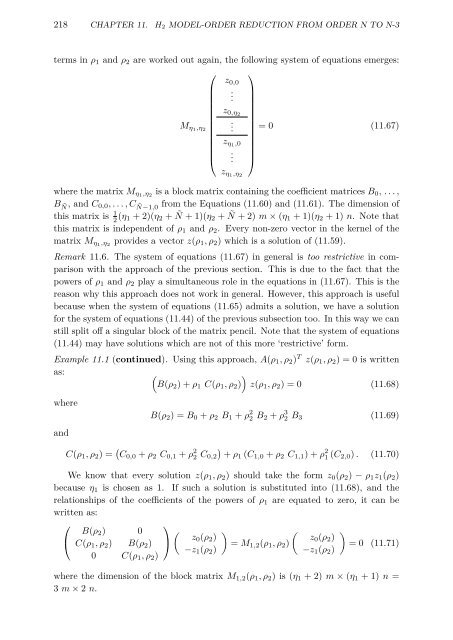link to my thesis
link to my thesis
link to my thesis
Create successful ePaper yourself
Turn your PDF publications into a flip-book with our unique Google optimized e-Paper software.
218 CHAPTER 11. H 2 MODEL-ORDER REDUCTION FROM ORDER N TO N-3<br />
terms in ρ 1 and ρ 2 are worked out again, the following system of equations emerges:<br />
⎛ ⎞<br />
z 0,0<br />
.<br />
z 0,η2<br />
M η1,η 2 .<br />
= 0 (11.67)<br />
z η1,0<br />
⎜<br />
⎝<br />
⎟<br />
. ⎠<br />
z η1,η 2<br />
where the matrix M η1,η 2<br />
is a block matrix containing the coefficient matrices B 0 ,...,<br />
BÑ, and C 0,0 ,...,CÑ−1,0 from the Equations (11.60) and (11.61). The dimension of<br />
this matrix is 1 2 (η 1 + 2)(η 2 + Ñ + 1)(η 2 + Ñ +2)m × (η 1 + 1)(η 2 +1)n. Note that<br />
this matrix is independent of ρ 1 and ρ 2 . Every non-zero vec<strong>to</strong>r in the kernel of the<br />
matrix M η1,η 2<br />
provides a vec<strong>to</strong>r z(ρ 1 ,ρ 2 ) which is a solution of (11.59).<br />
Remark 11.6. The system of equations (11.67) in general is <strong>to</strong>o restrictive in comparison<br />
with the approach of the previous section. This is due <strong>to</strong> the fact that the<br />
powers of ρ 1 and ρ 2 play a simultaneous role in the equations in (11.67). This is the<br />
reason why this approach does not work in general. However, this approach is useful<br />
because when the system of equations (11.65) admits a solution, we have a solution<br />
for the system of equations (11.44) of the previous subsection <strong>to</strong>o. In this way we can<br />
still split off a singular block of the matrix pencil. Note that the system of equations<br />
(11.44) may have solutions which are not of this more ‘restrictive’ form.<br />
Example 11.1 (continued). Using this approach, A(ρ 1 ,ρ 2 ) T z(ρ 1 ,ρ 2 ) = 0 is written<br />
as: (<br />
)<br />
B(ρ 2 )+ρ 1 C(ρ 1 ,ρ 2 ) z(ρ 1 ,ρ 2 ) = 0 (11.68)<br />
where<br />
and<br />
B(ρ 2 )=B 0 + ρ 2 B 1 + ρ 2 2 B 2 + ρ 3 2 B 3 (11.69)<br />
C(ρ 1 ,ρ 2 )= ( C 0,0 + ρ 2 C 0,1 + ρ 2 2 C 0,2<br />
)<br />
+ ρ1 (C 1,0 + ρ 2 C 1,1 )+ρ 2 1 (C 2,0 ) . (11.70)<br />
We know that every solution z(ρ 1 ,ρ 2 ) should take the form z 0 (ρ 2 ) − ρ 1 z 1 (ρ 2 )<br />
because η 1 is chosen as 1. If such a solution is substituted in<strong>to</strong> (11.68), and the<br />
relationships of the coefficients of the powers of ρ 1 are equated <strong>to</strong> zero, it can be<br />
written as:<br />
⎛<br />
⎞<br />
B(ρ 2 ) 0 ( )<br />
( )<br />
⎝ C(ρ 1 ,ρ 2 ) B(ρ 2 ) ⎠ z0 (ρ 2 )<br />
z0 (ρ<br />
= M 1,2 (ρ 1 ,ρ 2 )<br />
2 )<br />
= 0 (11.71)<br />
−z 1 (ρ 2 )<br />
−z 1 (ρ 2 )<br />
0 C(ρ 1 ,ρ 2 )<br />
where the dimension of the block matrix M 1,2 (ρ 1 ,ρ 2 )is(η 1 +2) m × (η 1 +1) n =<br />
3 m × 2 n.

















